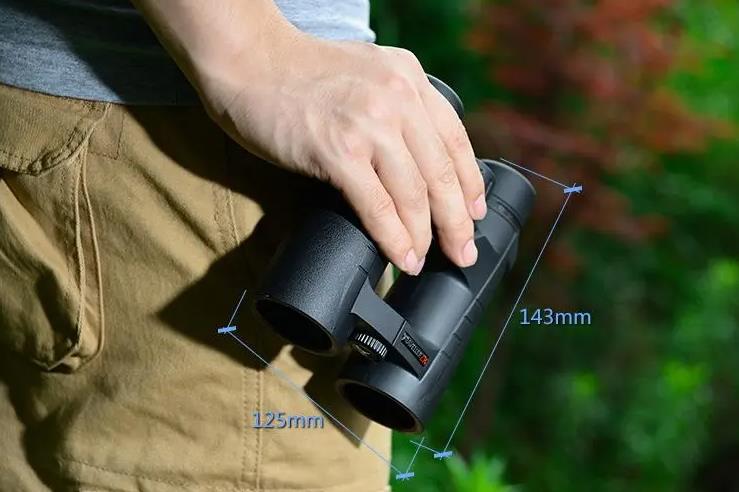As living standards improve, people gradually pay attention to leisure activities. Whether it is outings, bird watching, watching dramas, or stargazing, a pair of binoculars with good performance can greatly expand your vision and increase the fun of leisure. Binoculars can be seen everywhere in the market, and there are so many types that it is dazzling. Many operators are ignorant. If consumers do not have some basic knowledge, it is a small matter to randomly choose one and spend money but not get the expected effect. If you buy a product of poor quality, not only can you not enjoy a truly comfortable picture with your eyes, but it may also cause damage to your eyesight, which is really not worth the loss. Therefore, here we recommend that if you want to buy a suitable and high-quality telescope, you must have basic knowledge.
The following provides some references for selection: The considerations for choosing binoculars are mainly the size of the aperture, the magnification and the quality of the lens.
(1) Aperture size: The size (diameter or aperture) of the objective lens (the lens facing the target in the front of the telescope). The most common apertures of binoculars on the market are 20mm to 70mm. For example, if the telescope is marked 12x25, the 25 represents the aperture, which is 25mm (2.5 cm), and the 12 represents its magnification. The larger the aperture, the larger the volume. The aperture size is closely related to the light-gathering power (brightness) and resolution (clarity) of the telescope. The 12x25 and 12x50 binoculars are both 12 times, but the brightness and clarity of the latter are definitely higher than the former. When considering the aperture size of binoculars, there are only two options: 1. If you are going to watch concerts, various ball games, climb mountains, go on picnics, etc., where portability is the priority, choose a small or medium-sized model (less than 35mm). It is smaller and lighter, but it will inevitably sacrifice brightness and resolution. 2. If high brightness and high resolution are the priorities for astronomical observation, nighttime observation or long-distance observation, it is better to choose a larger aperture. If you are worried that it is too large and heavy, and you may get tired after long-term observation, most of the current medium-aperture binoculars have tripod fixing holes, which can be fixed on a general camera tripod. This not only reduces the burden on your hands, but also greatly improves stability.
(2) Magnification: When choosing a telescope, most consumers consider the magnification first, thinking that the higher the magnification, the better. This is actually not correct. A higher magnification does not mean a clearer image. The aperture also becomes larger. Therefore, the magnification should be sufficient. The advantage of binoculars is that they are easy to carry and highly maneuverable. If a higher magnification is required for long-distance observation, it is recommended to choose a ground-based monocular for better results.
(3) Lens quality: This is the most difficult item for most people to understand. The optical part of a binocular is composed of: objective lens, eyepiece, and prism.
1. Objective lens: This is the lens at the front end of the two sets of binoculars that is closest to the target object. The quality of the image is directly related to the quality of the objective lens. Most general products are achromatic objective lenses composed of two lenses. A few high-quality binoculars use three lenses, or use special material lenses such as ED and fluorite to reduce the influence of chromatic aberration.
2. Eyepiece: When using a telescope, the lens group close to the eye is called the eyepiece (left and right eyes). The typical eyepiece is composed of three optical lenses. The field of view of the eyepiece itself is about 50 degrees. The actual field of view is the eyepiece field of view divided by the magnification. If you want to have a larger field of view and maintain a good image around the field of view with the same magnification binoculars, you need more lenses and a more complex design to correct it, and the price will be relatively higher.

3. Prism: If the telescope only has the combination of the objective lens and the eyepiece, the image you see is reversed up and down, left and right. Therefore, a set of erecting prisms must be added to the optical path between the objective lens and the eyepiece to turn the image we see through the telescope into a normal direction. The prism material is generally BAK-7 glass. More advanced models will use high-refractive-index BAK-4 prisms to make the image brighter. Straight-tube binoculars must use roof prisms, which are more difficult to make and usually more expensive.
The above optical common sense will be helpful. Here are three principles for your reference when purchasing: 1. When you consider the convenience of carrying and choose a small model, the magnification should not be too high, otherwise you may be disappointed because the brightness is too low. 2. You must understand the purpose of using the telescope? Choose one that suits your needs. 3. Find a professional company and tell it in detail about your purpose and budget. I believe that as long as it is a dedicated professional company, it will definitely give you satisfactory service.

